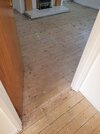You are using an out of date browser. It may not display this or other websites correctly.
You should upgrade or use an alternative browser.
You should upgrade or use an alternative browser.
Squeeky creeky floor boards help!!!
- Thread starter fitzykev
- Start date
D
Deleted member 174758
What type of floor? Many repairs? Condition of floor?
- Joined
- 11 Dec 2012
- Messages
- 1,553
- Reaction score
- 395
- Country

I hear talcum powder is good to put down after screwing down is this right?
No, roll on deodorant is better
D
Deleted member 174758
I hear talcum powder is good to put down after screwing down is this right?
No, roll on deodorant is better
The best solution is to screw them down properly with the right type and number of screws pulled up tightly. A good, if expensive, screw for this type of work is the Floor-Tite, as sold by places such as Toolstation. Even then there might still the possibility of some creaks if, for example, the sole plate of a wall has been nailed down onto a joist, but the nail has just grazed the joist because it was wrongly driven. Talcum powder doesn't do much - it's an old wive's tale - stopping movement by properly fixing is more likely to achieve a result
Yes, because nails can move. Traditionally floors were nailed down with cut nails:Better than floorboard nails?
which because of their wedge shape tend to resist pull-out (and squeaking), but they are hard work to drive and require a heavier hammer than the more modern oval nails or French (round wire) nails. They are not much used these days. The problem with adding more cut nails or round nails, though, is that you risk splitting the boards (because you are nailing near the ends), whilst ovals may not achieve the amount of pull down you are after unless you drive them in pairs in divergent directions (i.e one angled slightly in away from the end of the board, the next angled in the opposite direction)

